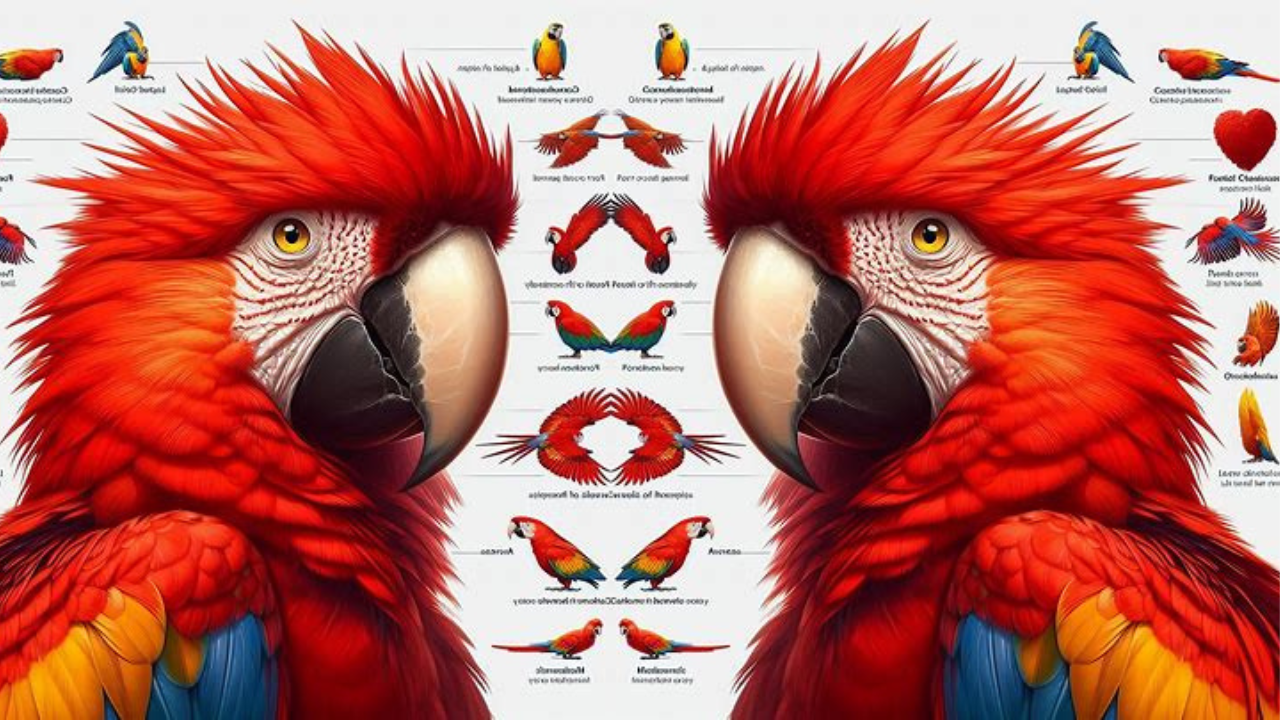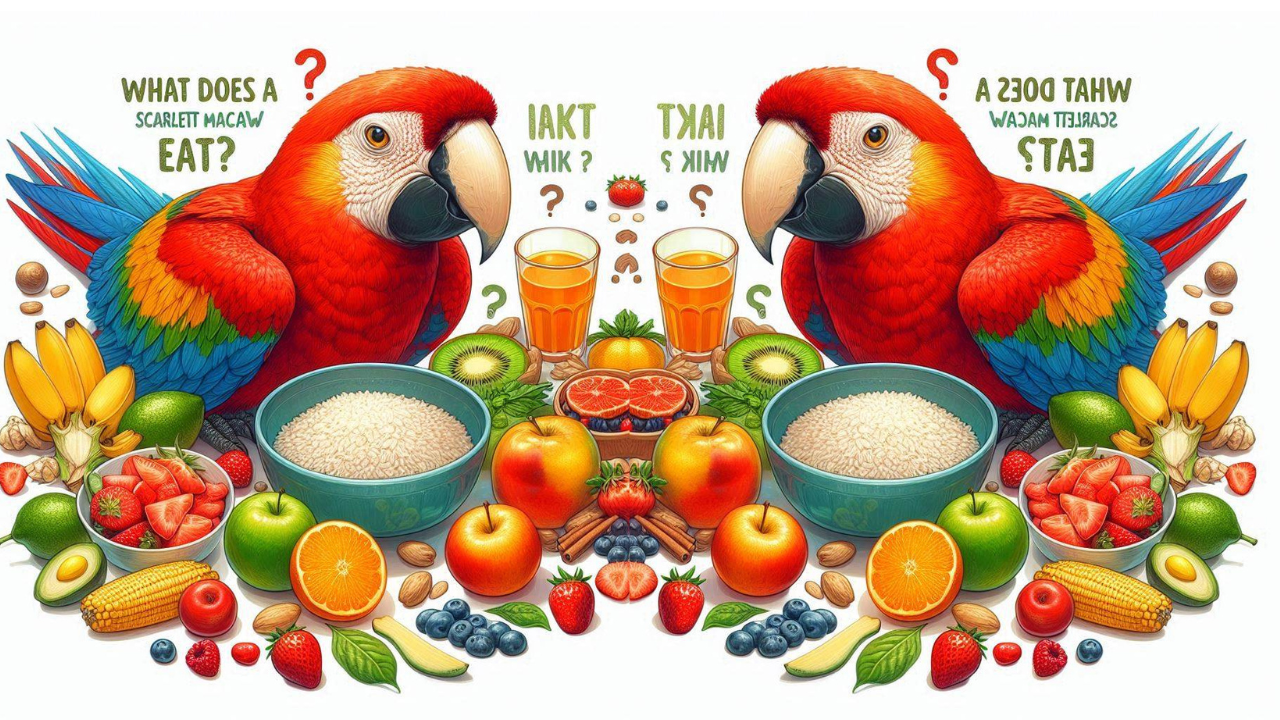What is a Scarlet Macaw?
The Scarlet Macaw (Ara macao) is a large, brightly colored parrot in Central and South American rainforests. Furthermore, Its feathers are mostly bright red, with blue and yellow feathers on the wings and tail. This beautiful bird has a strong, curved beak well-suited for cracking hard nuts and seeds. The Scarlet Macaw is an interesting bird famous for its lively personality. With proper care and attention, Scarlet Macaws can be loving and playful companions for seasoned bird owners
Overview Of Scarlet Macaw
- Common Name: Scarlet Macaw
- Scientific Name(s): Ara macao
- Adult Size: 32–39 inches (81–99 cm) long, with a wingspan of approximately 3 feet; slightly larger by region (Central American birds).
- Life Expectancy: 50–80 years in captivity; 40–65 years in the wild.
- Weight & Color: Weigh about 2.2 pounds (1 kg); has bright red feathers with blue and yellow wing bands, and a light-colored upper beak with a black lower beak.
Origin & History
- The Scarlet Macaw (Ara macao) is a colorful parrot of Central and South American humid evergreen forests. Furthermore, Scarlet macaws occur in humid evergreen forests from sea level to 1,000 meters (around 0 to 3,280 feet). Its range goes from southeastern Mexico to nations such as Guatemala, Belize, Colombia, Ecuador, Brazil, and Amazonian Peru.
- In the past, Scarlet Macaws ranged as far north as the Gulf Coast state of Tamaulipas along the coast from Tampico, about 1,800 km from Chaco, up to the late 19th century.
- They also occurred in the American Southwest, and indications are that ancestral Puebloan individuals obtained these birds via long-distance trade networks from Mesoamerica.
- In Costa Rica, Scarlet Macaws used to inhabit approximately 85% of the land. Now, only two viable groups can be found, underlining the plight of the species in some areas. The Scarlet Macaw has been an object of interest and veneration by many civilizations through the ages.
Scarlet Macaw Characteristics

The scarlet macaw (Ara macao) is a colorful parrot of the rainforests of Central and South America. 33 inches (84 cm) long, with its elongated tail, it weighs an average of 2.2 pounds (1 kg). Its feathers feature an impressive mix of red, yellow, and blue, with a white, almost featherless face patch. With a strong beak, the scarlet macaw can crack open hard nuts and seeds. So, they can survive for 40 to 50 years in the wild, though some of them have lived up to 75 years when they are in captivity. Scarlet macaws are very good fliers, as they can achieve a speed of 35 miles per hour.
Scarlet Macaw Habitat: Where Does the Scarlet Macaw Live?
The Scarlet Macaw (Ara macao) is found in a wide variety of habitats throughout Central and South America. Its range includes southeastern Mexico, through Guatemala, Belize, Honduras, Nicaragua, Costa Rica, and Panama, to South American countries including Colombia, Ecuador, Peru, Bolivia, and Brazil.
These colorful parrots inhabit moist, lowland subtropical rainforests with closed canopy cover. These parrots also inhabit open woodland, riverbanks, mangrove forests, and savannas.
They typically live between sea level and elevations of 500 meters, but they reach altitudes of 1,000 meters in certain areas. The parrots tend to visit riverbanks and clay licks, which offer minerals necessary for digestion. Thus, they are still closely linked with tropical and subtropical forests that have the resources they need to survive.
Is the Scarlet Macaw Endangered?
The Scarlet Macaw (Ara macao) is listed as “Least Concern” by the International Union for Conservation of Nature (IUCN) currently. The Scarlet Macaw is currently facing a population decline, and it is estimated at between 50,000 and 500,000 mature individuals. This reduction is mainly attributed to activities like deforestation, wildlife trade, and poor enforcement of current conservation legislation.
Organizations such as the Macaw Recovery Network and the World Parrot Trust are working diligently to conserve and restore Scarlet Macaw populations through conservation efforts, habitat restoration, and community education programs.
Scarlet Macaw Predators
Scarlet macaws are threatened mainly by different species during their lifespan. Monkeys, toucans, and snakes tend to prey on eggs and fledglings, taking advantage of their vulnerability in nests. Adult scarlet macaws, being large and capable of flight, are less vulnerable but can still become victims of powerful predators like jaguars, harpy eagles, and hawk-eagles. These predators and issues scarlet macaws encounter in their natural habitats
Care of Scarlet Macaw
Appropriate care is crucial to ensure the Scarlet Macaws’ health and happiness. The diet must be well-balanced with 40-70% high-quality commercial parrot pellets, 10-35% vegetables (broccoli, carrots, spinach), and 10-40% fruits (melons, berries, apples). Daily bathing, provided 3-5 times a week, keeps feathers healthy; misting or the use of a shower perch will suffice. Hence, regular veterinary check-ups are required to track health and avert potential problems.
Exercise
Exercise and early training are essential to the physical and mental well-being of Scarlet Macaws. So, they are released from their cage for at least two hours daily. The time spent outside of the cage provides them with a chance to stretch their wings and engage with their environment.
Training
Introducing the bird to early training through positive reinforcement techniques such as praise and treats encourages positive behavior and strengthens the bird-owner relationship.
Providing multiple chew toys stresses their strong beaks and keeps them from getting bored. Patience and consistency in training are vital in establishing trust and owning a well-adjusted pet.
Health Issues of Scarlet Macaw
Scarlet Macaws are susceptible to several health issues. Some of the frequent issues include malnutrition, which may lead to lethargy, weight loss, and susceptibility to infections. Respiratory infections may result from drafts or poor air quality. Behavioral issues are feather plucking due to stress, boredom, or social isolation. Regular veterinary visits, proper diet, and a healthy environment are the best ways to prevent and treat these health problems.
Scarlet Macaw Diet: What Does a Scarlet Macaw Eat?

Scarlet Macaws need a balanced diet that mimics their natural diet. They feed on a variety of seeds, nuts, fruits, berries, leaves, and other vegetation in the wild. They need more fat content than most other birds.
In captivity, high-quality commercial parrot pellets are optimal at comprising 40-70% of their diet. 10-35% must also be derived from vegetables such as capsicum, broccoli, chili, corn, carrot, zucchini, squash, spinach, pumpkin, sweet potato, beans, and peas, supplemented with sprouted seeds. The fruits must contribute 10-40% and must consist of melons, strawberries, bananas, blueberries, grapes, peaches, pears, and apples (see to it that all the stone fruits and apples have their seeds removed).
Feed them a mixed diet that not only caters to their nutritional needs but also keeps their minds stimulated.
Scarlet Macaw Flying
These powerful fliers have flight speeds of up to 35 miles per hour (56 kilometers per hour). With a broad wing span of roughly 111.7 to 119.3 centimeters (44 to 47 inches), nearly double their body length.
This broad wingspan, combined with strong flight muscles, provides the agility to fly through thick rainforests. Surprisingly, bonded pairs fly together, their wings nearly touching, showing their strong social bonds.
Scarlet Macaw Price: How Much Does a Scarlet Macaw Cost?
A Scarlet Macaw cost is based on the breeder’s age, health, and reputation. Overall, the birds range in price from $2,000 to $3,000. Setup charges, like a huge cage and equipment, range from $200 to $850, and monthly payments for food, toys, and maintenance typically range from $20 to $800.
Additionally, regular expenses consist of food, housing, and veterinary care, which are vital to the well-being of the bird.
Scarlet Macaw Facts
- Size: Scarlet Macaws are some of the largest parrots, measuring up to 33 inches (84 cm) from beak to tail.
- Diet: Their strong beaks allow them to easily crack open nuts and seeds.
- Social Behavior: Such intelligent birds congregate in societies of 10 to 30 members, which require socialization and stimulation, or else they might get bored.
- Cultural Significance: The Bororo group from Brazil considers macaw to be a god-ancestor messenger.
These points provide evidence of Scarlet Macaw’s amazing characteristics.
Conclusion
The Scarlet Macaw is valued for its plumage and high intelligence. Nevertheless, their habitat loss and illegal trade that has led to their population declines, particularly in Central America. For instance, Belize has fewer than 250 birds, classifying the species as endangered in the country. Hence, conservation initiatives such as the Scarlet Macaw Reintroduction Project are instrumental in boosting populations in countries like Costa Rica. To maintain the survival of this mythical bird, it is important to support these conservation efforts and protect their natural habitats.
FAQs on Scarlet Macaws
- How long does a Scarlet Macaw live?
- Scarlet Macaws can live up to 80 years in captivity. However, their lifespan is 40 to 50 years.
- What do Scarlet Macaws eat?
- Their diet in the wild consists of fruits, nuts, and seeds.
- Are Scarlet Macaws endangered?
- The Scarlet Macaw is classified as Least Concern (LC) by the IUCN Red List. So, it is decreasing in population.
- Do Scarlet Macaws talk?
- They can mimic sounds and human words, although the quality varies from bird to bird.
- How big do Scarlet Macaws get?
- They reach 33 inches (84 cm) in length, more than half of which is because of their long tail.


Эскорт услуги в Санкт-Петербурге — Escort Piter https://escort-piter.com/
Balloons Dubai https://balloons-dubai1.com stunning balloon decorations for birthdays, weddings, baby showers, and corporate events. Custom designs, same-day delivery, premium quality.
ultimate AI porn maker generator. Create hentai art, porn comics, and NSFW with the best AI porn maker online. Start generating AI porn now!